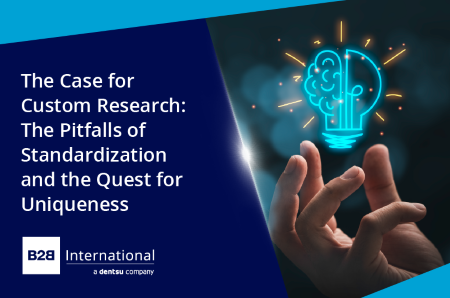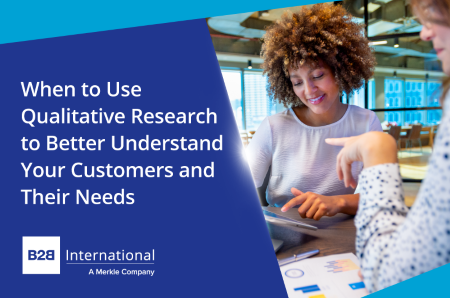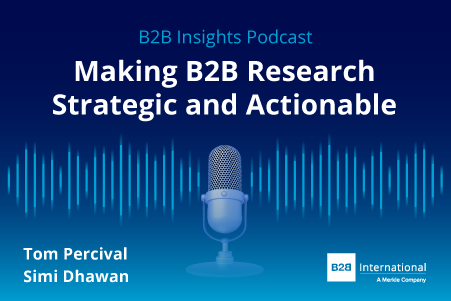
New tools and technologies that speed up processes and reduce the time spent on repetitive tasks are a welcome addition to the market research world. The days of relying solely on manual data checks, Excel pivot tables, and transcription from scratch are behind us. Automation has streamlined many aspects of research projects, boosting efficiency. However, how much further can this go without compromising the quality and impact of the insights gathered?
The business landscape is becoming increasingly complex, with B2B decision makers’ behaviors and preferences evolving rapidly. Yet, recent research by B2B International shows that brands are more likely than ever before to sound and act the same. This made me consider the implications of relying solely on self-serve tools and dashboards to gather and interpret data. Is poor insight adding to the challenge that brands are facing to stand out?
Adoption of standardized approaches may be contributing to the challenge of distinctiveness, with insight projects failing to capture the nuanced understanding needed for strategic decision making. This is where custom market research should shine, providing tailored insights that reflect the unique context of your business.
With new tools enabling efficiencies, where should researchers and decision makers ensure that skill and expertise are focused?
Questionnaire design
The phrase “good research is asking the right questions of the right people” has guided me throughout my career. This principle remains at the heart of effective research. If individuals who are not decision-makers for the product or service in question are interviewed, the results will clearly lack reliability. Whilst leading questions or questions asked in an illogical order will fail to deliver an objective view.
If you have ever embarked on the task of designing a questionnaire to be used to address a unique business challenge such as understanding the dynamics of a complex new market or understanding customer perceptions, you will know that this is not an easy task. There is a long list of considerations, including coverage of the research objectives, ensuring key stakeholders will obtain the information they need, questions phrased in an easy-to-understand format using customer friendly language (i.e., not sales or marketing jargon).
Standardized questions are crucial for tracking key metrics over time, such as the Net Promoter Score or brand funnel metrics. Yet, there is no standard list of attributes suitable for every voice of the customer or brand survey. The art of questionnaire design is one of the most crucial skills a researcher possesses, ensuring that objectives are addressed effectively and efficiently.
AI tools can assist in this process providing templates and inspiration for answer lists, but skilled researchers bring irreplaceable value. Researchers will ensure that the right types of questions are included to cover the research objectives and they are asked in a logical order and that screeners are designed to avoid inadvertently disclosing the subject of research before confirming the correct decision maker is being interviewed. In addition, we have tested hundreds of questionnaire variations, we know what can cause distortion in the data, for example introducing the use of color in scales in a repeat piece of research.
Tailored methods
Susan Cain’s book “Quiet: The Power of Introverts in a World That Can’t Stop Talking” provides a clear overview of how different people process information and contribute. This concept also applies to research participation preferences. A one-size-fits-all approach, especially in qualitative research, is unlikely to cater to everyone.
A simple example being how different people respond to the invitation to participate in an interview. Some people are happy to participate and require no further information until the interview begins, often several days after initially agreeing to participate. Often, these people are also comfortable sharing their unprompted and initial thoughts to questions. Others may only feel comfortable if they have a sense of the topic and an opportunity to consider some key thoughts beforehand. The outcome of interviews where people are comfortable sharing their views lead to better conversations and insights. It should be noted that sharing information about the topic of the interview is not always possible, especially when the objective is to gather initial, top-of-mind reactions to a concept.
Respondent preference aside, mixed method approaches are common in B2B research for the simple reason that finding B2B decision makers on reputable online panels in sufficient numbers is increasingly challenging. Relying solely on one recruitment method e.g., recruitment via online panels alone will limit the size of the audiences that can be reached.
One final thought around standardization in qualitative research. This approach is well suited to exploring and understanding new topics through open questions that guide a conversation between the interviewer and respondent. A skilled interviewer knows when it is appropriate to go off-script and explore in more detail, and how to get the most out of each interview. Good qualitative research takes time, allowing for review and adjustments of the questioning strategy if needed. This flexibility would be impossible if the same topic guide was used throughout the fieldwork period, as gaps would only be identified during analysis, when it’s too late to adjust.

Getting to insights in reporting
There are a lot of definitions of what an insight is, for example ‘a fresh perspective that reveals new paths to business success.’ An alternative could be described by a question that we often ask ourselves before sharing a first draft of a report with a client: ‘What have we found that the client didn’t already know.’ We measure our success by whether we uncover anything new or different – if not we’ve failed.
Getting to the core insight or insights from a project takes time – the type of time that can’t be sped up. This includes discussing findings with the research team, building on thoughts, and getting feedback from clients.
Automated analysis brings time efficiencies to report writing, especially when a clear structure is needed, such as for multiple market or business unit reports. Various tools can help researchers update and populate charts, but there is a risk that nuances or differences and therefore the insight within specific data cuts may be missed. You may recall the mantra that ‘data does not lie’ but it can hide key insights. For example, analyzing a data set at an overall level may miss significant differences in perceptions between markets or customer groups. In addition, automated tools alone do not have the expertise that statisticians can bring to the table.
Automated tools (today) struggle with of tailored reports, where a story-led narrative is required to capture the attention of senior decision makers. These reports are built from scratch and often visualized by experts in data visualization. A strong and compelling narrative is built around frameworks using inputs from multiple questions asked in the survey as well as secondary information on the business and broader market. This approach is far from reporting question by question and commenting on observations; instead, it involves identifying patterns, causes and connections.

Custom research brings value
I am an advocate of technology, but its application must ensure that market research delivers a competitive advantage. Good custom market research, tailored to your business, can uncover unique insights that drive strategic decision-making and offer a competitive edge in a complex market.
By leveraging both technology and human expertise, custom agencies ensure high-quality, relevant, and actionable data. This approach not only enhances the usefulness of market research but also helps businesses navigate market complexities and achieve their strategic objectives.
Readers of this article also viewed:
B2B Insights Podcast #61: How to Ensure B2B Market Research is Strategic and Actionable B2B Insights Podcast #62: How to Achieve World-Class Quality in B2B Market Research Transforming Tradition: Embracing Innovation in B2B Research When to Use Qualitative Research to Better Understand Your Customers and Their Needs How to Write a Great Research Brief How to Reach Senior Professionals in B2B Market Research



